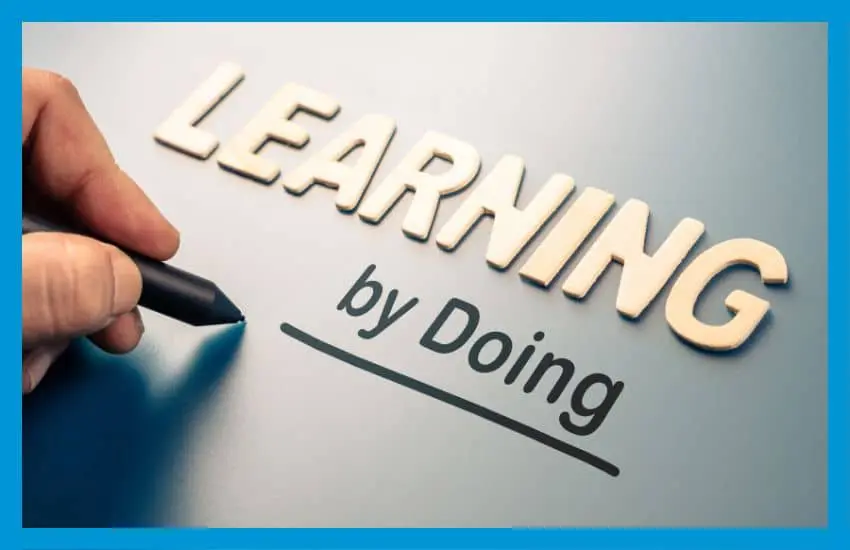Learning by doing is a growing methodology due to its advantages in learning. It seeks to acquire knowledge while developing skills and abilities to solve real problems that students may encounter throughout their life and professional experience.
Proponents of this methodology argue that discussions, practice, and teaching or exposing to others what you know are active methods with a higher rate of knowledge assimilation.
However, despite its benefits, many people are still unaware of what it is and consists of.
Given its importance, we explain in detail what learning is by doing and its methodology.
What is learning by doing?
Learning by doing is an active learning methodology based on experience to assimilate concepts through actions. It also encourages the student to learn from mistakes and draw conclusions after analyzing the practice in a clear spirit of continuous improvement.
This is not a new concept, especially if we remember that Aristotle, as early as the 4th century BC, stated that “what we have to learn, we learn by doing.”
However, some theorists point to the late 19th century American pedagogue John Dewey as the father of renewed education based on the method that concerns us in this article. Dewey considered that education should be active.
The objective of learning by doing essentially seeks to prevent the student from forgetting the knowledge learned over time through experience instead of passively assimilating concepts through memory, making them much briefer.
The introduction of the “learning-by-doing” methodology in companies is also helping to improve employee commitment and performance.
This is because people acquire knowledge and, at the same time, develop skills that they can transfer to other situations or colleagues.

Learning by doing methodology
The learning by doing methodology is an active technique that focuses, as we have explained a few lines ago, on creating knowledge through experience and reflection on it, considering error as part of learning.
It is based on the four essential phases shown below.
Observation of the experience
The person is encouraged to actively observe the experience they are carrying out in response to a given problem.
Reflection based on the observation
As a result of the observation, the student can issue different hypotheses, strengthening his capacity to internalize the exercise.
Subscribe today to SMOWL’s weekly newsletter!
Discover the latest trends in eLearning, technology, and innovation, alongside experts in assessment and talent management. Stay informed about industry updates and get the information you need.
Simply fill out the form and stay up-to-date with everything relevant in our field.
Abstract conceptualization
Based on the hypotheses raised, he can form abstract concepts that must be interpreted and assimilated to reach the final phase.
Conclusions and experimentation
In this last stage, the student has sufficient resources to check the conclusions drawn from the initial experience and apply them in new environments, establishing his learning on solid foundations.
This technique uses methods such as problem-, project- or challenge-based learning, or cooperative learning that places the student as the protagonist at the center of their education.
To be successful, it is necessary to provide the autonomy needed for the learner by encouraging critical thinking towards the experience and oneself through self-evaluation.

Advantages of learning by doing
The learning-by-doing methodology applied to e-learning provides a series of benefits that, as stated by scholars in the field, improve the success rate of training programs and encourage positive and constructive attitudes towards obstacles, among other advantages.
Active learning and motivation
By giving the learner an active role, they know their responsibility in the process and their evolution.
In the course of learning, the learner creates valuable content and increases his motivation.
Autonomous learning and critical thinking
The learner develops his critical thinking in the face of a problem and transfers his knowledge effectively because it is his own experience.
Skills development
This practice promotes the development of soft skills such as adaptability, creativity, teamwork, and decision-making, among others highly valued by companies today.
Likewise, the learning by doing method applied to in-company training reinforces the commitment of the teams that perceive the necessary skills to develop and achieve their professional career plans.
With the evolution of technology, this educational strategy is being stimulated thanks to tools such as augmented reality or serious games, which pose a problem to be solved practically by the student.
Do you know that we can help you to implement the philosophy of learning by doing with our proctoring products?
Find out practically what we can do for you by requesting a free demo in which we will share innovative and customized solutions to create safe and effective environments for your educational programs.
Download now!
8 interesting
facts
about proctoring
Discover everything you need about online proctoring in this book to know how to choose the best software.
Fill out the form and download the guide now.
And subscribe to the weekly SMOWL newsletter to get exclusive offers and promotions.
You will discover all the trends in eLearning, technology, innovation, and proctoring at the hands of evaluation and talent management experts.



